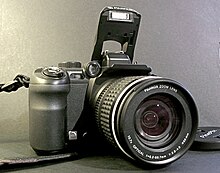Bridge are higher-end digital cameras that physically and ergonomically resemble DSLRs and share with them some advanced features, but share with compacts the use of a fixed lens and a small sensor. Like compacts, most use live preview to frame the image. Autofocus is achieved using the same contrast-detect mechanism, but many bridge cameras feature a manual focus mode, in some cases using a separate focus ring, for greater control.

Due to the combination of large physical size but a small sensor, many of these cameras have very highly specified lenses with large zoom range and fast aperture, partially compensating for the inability to change lenses. To compensate for the reduced sensitivity of their small sensors, these cameras almost always include an image stabilization system to enable longer handheld exposures.
These cameras are sometimes marketed as and confused with digital SLR cameras since the appearance is similar. Bridge cameras lack the reflex viewing system of DSLRs, have so far been fitted with fixed (non-interchangeable) lenses (although in some cases accessory wide-angle or telephoto converters can be attached to the lens), and can usually take movies with sound. The scene is composed by viewing either the liquid crystal display or the electronic viewfinder (EVF). Most have a longer shutter lag than a true dSLR, but they are capable of very good image quality (with sufficient light) while being more compact and lighter than DSLRs. High-end models of this type have comparable resolutions to low and mid-range DSLRs. Many of these cameras can store images in a Raw image format, or processed and JPEG compressed, or both. The majority have a built-in flash similar to those found in DSLR



0 comments:
Post a Comment